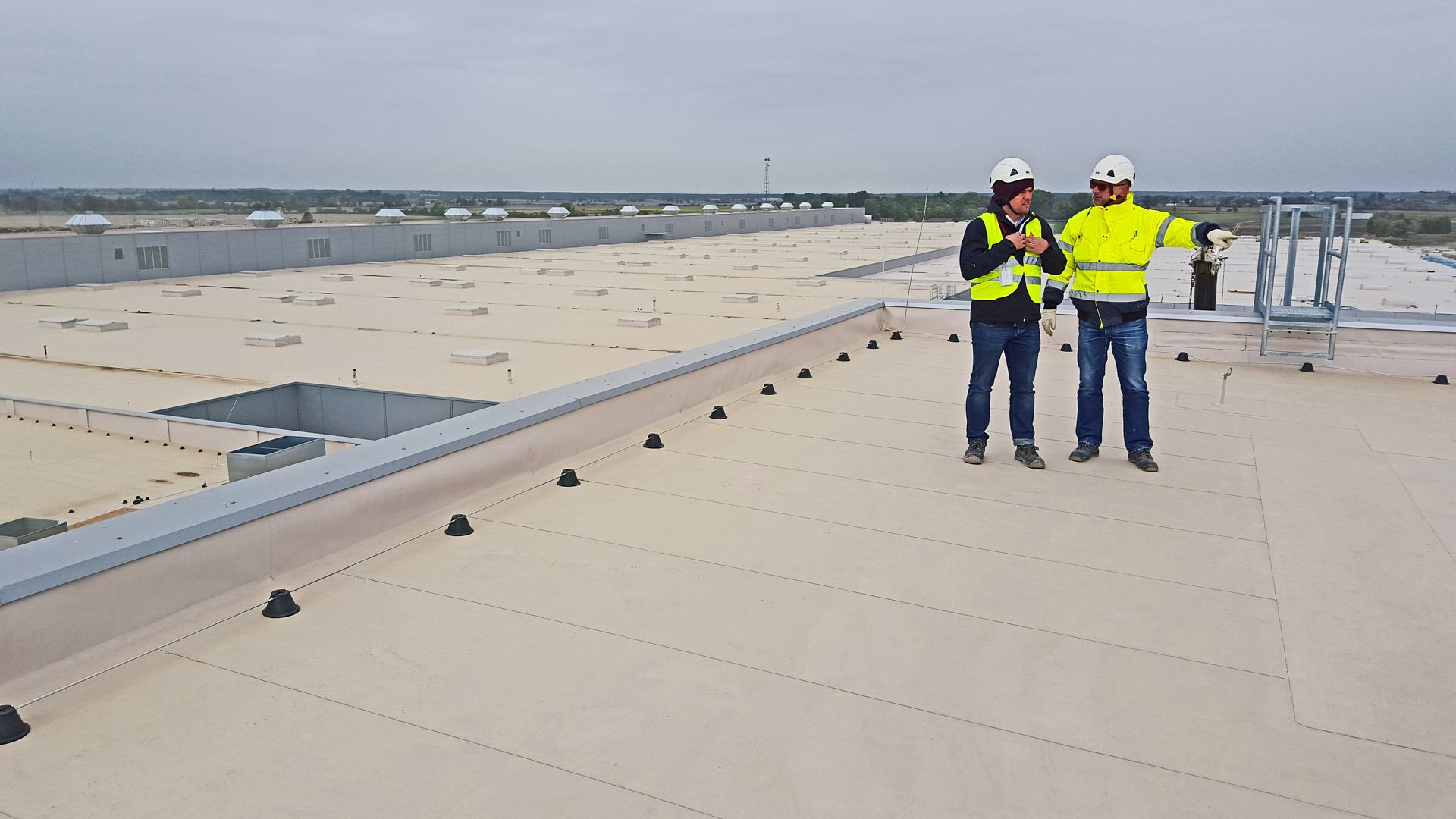IS IT POSSIBLE TO HAVE A MAINTENANCE-FREE ROOF? THE ANSWER IS... ALMOST
The nightmare of premature roof failure can keep facility managers and building owners up at night. Not only is premature roof failure a money pit, but it’s also a waste of a roof that could have lasted for many years if properly maintained.
Every roof system needs to be maintained in some way, and the trick is to discover the little problems before they become big ones. Check out these six simple tips for getting the longest service life out of your roof:
1. GET INVOLVED AND STAY INVOLVED
Too often, building owners don’t do their homework before selecting a roofing solution. They may rely on others, such as a contractor, architect, consultant, or purchasing department, to make the decisions. It is always better for the building owner to become educated so he or she can help make the purchasing decisions throughout the project. It’s the building owner who has to “live” with the end result.
2. SELECT A QUALITY ROOF SYSTEM FROM A RELIABLE MANUFACTURER
With a multitude of roof membranes to choose from, it may seem difficult to select one that will provide you with years, or even decades, of maintenance-free performance. The key is to look for a roof manufacturer that has a proven track record, has been producing roof membranes using the same formula for years, and can provide you with a list of completed projects of a similar size, system, location, and scope as your own.
Make sure the manufacturer is well-known in the industry and respected by top roofing contractors. The best contractors gravitate toward the best products, because they know that they’ll perform for decades. The manufacturer should also have local, direct field technicians available to assist with the job start and to conduct final inspections.
A quality roof system is also one that:
Is easy to inspect and repair if needed. Exposed or non-ballasted roof systems, such as those that are adhered or mechanically attached, are best. Doesn’t require recoating or resurfacing. To perform well over the long run, some roof systems need to be periodically “rejuvenated”, a significant maintenance item. Has hot-air-welded seams. Seams sealed with adhesives or tapes are known to become maintenance issues later on. Hot-air-welded seams, on the other hand, are stronger than the membrane itself and can withstand wind, weather and time.
To win a job, general contractors or roofing contractors may practice what’s called “value engineering,” a process in which they present a less expensive and often inferior product to the one specified. Although the upfront cost savings may seem appealing, in the long-run the less expensive alternative may also have a shorter life-cycle or rely on inferior details, resulting in more maintenance.
3. MAKE SURE YOUR ROOF IS PROPERLY DESIGNED
A roof can be designed to meet building codes, but still cause problems in the future. To help eliminate the need for maintenance on your roof and maximize life expectancy, there are a few things you should consider:
Slope: Build at least a minimum slope of one-quarter of an inch per horizontal foot into your roof. Water that ponds on a roof can lead to problems and premature deterioration of some roofing materials. A small hole in the roof membrane on a dead-flat roof could result in severe leakage and damage to the roof system.
Drainage: Drains should be located at roof low points to allow water to effectively run off. Secure the roof membrane and collar flashing with a clamping ring and cover with a basket to prevent debris from clogging the drain.
Penetrations: The fewer penetrations you have on the roof, the better. Locate HVAC units on the ground, if possible. Doing so will keep mechanics off the roof and reduce the risk of careless damage. Eliminate any odd-shaped penetrations such as I-beams. Allow enough space between clusters of penetrations so each penetration can be flashed individually.
Flashing and terminations: To ensure a durable, watertight roof system, vertical flashings should be extended at least 18 inches from the roof; up and over curbs for fans, skylights, and roof hatches; and up and over parapet walls. Care should be taken to properly terminate and seal perimeter edges. Develop roof details to minimize the reliance on sealant, which is a common source of maintenance.
Walkways: Roofing manufacturers offer durable compatible walkway systems to protect the roof system from damage by other trades who traffic the roof to service HVAC units, plumbing, and communications equipment. Specify walkways and insist that they be used.
Membrane thickness: Heavily trafficked roofs or roofs in areas that are prone to damage require thicker roof membranes to provide additional protection
4. CHOOSE AN APPLICATOR WHO IS TRAINED AND CERTIFIED
Today’s roofing systems are becoming increasingly complex. To help ensure a quality installation, i.e., one that provides years of maintenance-free performance, building owners should hire a roofing contractor who is trained and certified by the manufacturer. The best contractors compete for the top spots in the manufacturer’s applicator hierarchy because it helps to set them apart from their competition.
For a building owner, working with a manufacturer’s best roofing contractor can help eliminate the cost and hassle of emergency roof repairs because these contractors are trained in the best ways to install that particular roofing system. They often work with the manufacturer’s technical representatives to review and finalize the details before the product is installed. Some manufacturers also send their technical staff out to a job to monitor and inspect the installation itself. This can cut down on problems caused by improperly installed roofing systems.
Before selecting a contractor, consider holding a pre-bid meeting with the contractor candidates and the roof membrane manufacturer. This helps to ensure that everyone, including the building owner, is aware of the project logistics, and construction schedule, and that the bidders are using acceptable installation procedures and details.
5. EDUCATE YOURSELF ON NORMAL DAMAGE
It's imperative for an owner or facility manager to learn about what you might find when you head up to the roof. There are three common occurrences that account for the majority of typical damage you will likely come across:
Worker-caused: Contractors can cause inadvertent damage to the roof, especially if they aren't trained on the best practices for caring for it. For example, a worker may drop a tool that causes a puncture or spill something that eats away at certain roof membranes. Workers may also cause harm to certain types of roofs simply by spending too much time in one place - that excessive pressure could cause deterioration.
Weather: Rain and other sources of water intrusion can ruin insulation or cause serious damage if entered into occupied space. Leaves and debris need to be cleaned from drains on a regular basis. In addition, freeze-thaw cycles can cause certain materials to expand and contract, which could potentially damage roofs or open seams if the seams are not hot-air welded.
Regular wear and tear: Inspecting your roof from time to time, especially when the weather is nice, will help you spot age-related deterioration and faulty seams before moisture becomes an issue.
6. INSPECTIONS ARE NOT OPTIONAL
Owners and facility managers often take an "out of sight, out of mind" approach when it comes to their roof. The truth is, you should be inspecting your roof for damage twice a year at bare minimum. Quarterly inspections with a solid drain cleaning added to the spring and fall evaluations will help keep your roof in the best shape. The fall cleaning is particularly important because fallen leaves can clog drains and create ponding water, which can be an issue for some types of roofs.
Roofs can be virtually maintenance free. A ‘team approach’ is critical to deliver long-lasting, headache-free roof systems. The owner needs to be involved throughout the process and partner with proven manufacturers and established roofing contractors. Although upfront costs are important, it is just as important to analyze life-cycle costs to make sure you are getting the best return on your investment.

